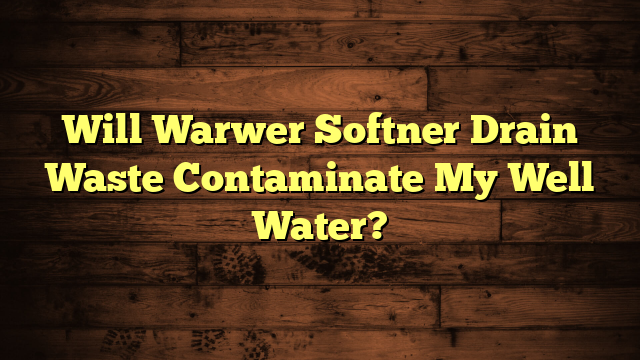Will Warwer Softner Drain Waste Contaminate My Well Water?
If you're using a water softener, you might wonder about the impact of its drain waste on your well water. The brine discharge, often packed with sodium and other chemicals, could pose risks to your groundwater quality. Without proper management, it's possible that contaminants could seep into your well, affecting everything from taste to safety. What does this mean for your drinking water, and how can you guarantee it remains safe? Let's explore the potential consequences and necessary precautions you should take.
Key Takeaways
- Water softener drain waste can introduce excess sodium and chloride into groundwater, potentially increasing salinity levels that harm plants and aquatic life.
- High chloride levels from brine discharge may corrode plumbing and negatively affect the taste of well water.
- Contaminants like heavy metals and chemical additives from softeners might leach into waste, risking groundwater contamination.
- Regular water testing is essential to monitor well water quality and detect changes due to water softener discharge.
- Following local disposal regulations and proper maintenance practices can help minimize the risk of well water contamination from water softeners.
Understanding Water Softeners
Water softeners are commonly used devices that help reduce the hardness of water, making it more suitable for everyday tasks like washing dishes and laundry.
When you deal with hard water, you may notice mineral build-up on your appliances and fixtures, which can affect their efficiency and lifespan. Understanding the importance of water quality is vital, as it directly impacts your home's plumbing and the effectiveness of soaps and detergents.
There are several softening methods available, each with its own advantages.
Ion exchange is one of the most popular techniques, where calcium and magnesium ions in hard water are replaced with sodium ions. This not only softens the water but also improves its overall quality, making it easier for you to clean and maintain your household items.
Another method includes reverse osmosis, which filters out impurities and minerals, providing you with cleaner water.
How Water Softeners Function
To understand how water softeners work, you need to look at the ion exchange process, where hard minerals are replaced with softer ones.
You'll also want to contemplate how the brine discharge mechanism operates and its potential impact on water quality.
These elements are essential for evaluating whether a water softener might affect your well water.
Ion Exchange Process
At the heart of a water softener's functionality lies the ion exchange process, a method that effectively removes hard minerals like calcium and magnesium from your water supply.
When you install a water softener, it typically contains softening agents, often sodium or potassium ions, which play a vital role in this process. As hard water flows through the softener, it encounters resin beads coated with these softening agents.
During ion exchange, the hard minerals in your water are attracted to the resin beads, displacing the sodium or potassium ions. This exchange results in the hard minerals being trapped in the softener, while the softened water, now free of these problematic minerals, flows into your home.
The ion exchange process is efficient and can greatly reduce the scale buildup in your plumbing and appliances, enhancing their lifespan.
However, it's important to regularly maintain your water softener to guarantee peak performance. By replenishing the softening agents and keeping an eye on the system, you can enjoy the benefits of softened water without the hassle of hard water problems.
Brine Discharge Mechanism
When a water softener reaches the end of its ion exchange capacity, it employs a brine discharge mechanism to regenerate its resin beads. This process is essential for maintaining the efficiency of your water softening system.
Here's how it typically works:
- Brine Preparation: The unit mixes salt with water to create a concentrated brine solution.
- Regeneration Cycle: The brine is flushed through the resin beads, displacing the accumulated hardness minerals (calcium and magnesium).
- Brine Disposal: After the regeneration cycle, the leftover brine, now mixed with these minerals, must be disposed of properly.
- Wastewater Treatment Integration: Many systems are designed to channel this brine into your household's wastewater treatment system, ensuring it's handled responsibly.
Understanding the brine discharge mechanism is essential, especially if you're concerned about brine disposal and its potential effects on your well water.
Proper management of this process can mitigate risks associated with wastewater treatment and help protect your water supply. By staying informed, you can enjoy the benefits of softened water while minimizing environmental impact.
Impact on Water Quality
Water softeners greatly impact water quality by removing hardness minerals like calcium and magnesium from your supply. This process not only improves the feel and taste of your water but also helps prevent scale buildup in your pipes and appliances.
By exchanging these minerals for sodium or potassium ions, you enhance the overall effectiveness of soaps and detergents, leading to cleaner dishes and softer laundry.
However, it's vital to evaluate potential contamination sources associated with brine discharge from water softeners. If the brine is improperly disposed of, it can introduce higher sodium levels into the surrounding environment, potentially affecting groundwater.
You should regularly conduct water testing to verify your well water remains safe and free from contaminants. Monitoring your water quality helps you identify any shifts that might stem from your water softener or other external factors.
By being proactive, you can address any issues before they escalate, verifying your well water stays clean and healthy.
To summarize, while water softeners improve water quality, awareness of their impact on local ecosystems is important for maintaining safe drinking water.
Composition of Drain Waste
When you use a water softener, the drain waste produced contains various chemicals that can affect the environment.
It's essential to analyze the potential impact of these substances on well water and consider the risks of contamination.
Understanding the composition of this drain waste helps you make informed decisions about your water system.
Chemicals in Drain Waste
Drain waste from water softeners contains a mixture of chemicals that can affect well water quality. When you manage waste from your water softener, you need to be aware of the potential for chemical exposure. Understanding what's in that drain waste is vital for maintaining the safety of your well water.
Here are four common chemicals found in drain waste:
- Sodium: This is the primary exchange ion in most water softeners, which can lead to increased sodium levels in your well.
- Chloride: Often present alongside sodium, high chloride levels can harm aquatic life and affect your water's taste.
- Potassium: Some systems use potassium chloride instead of sodium, which can still have impact on well water.
- Sulfur Compounds: These may occur in smaller amounts and can contribute to unpleasant odors.
Proper waste management is essential. If you don't dispose of water softener drain waste correctly, you could inadvertently contaminate your well water.
Always consider the implications of these chemicals and take steps to protect your water source.
Environmental Impact Analysis
Understanding the composition of drain waste from water softeners is essential for evaluating its environmental impact on well water. The primary components of this waste often include sodium, chloride, and other minerals. These elements can greatly affect the surrounding soil and groundwater quality, especially if not managed properly.
Effective waste management practices are important to minimize potential harm to the environment.
When you consider environmental regulations, it's clear that proper disposal of water softener waste is necessary. Many regions have rules governing the discharge of salty drain waste to protect local water sources. If the drain waste is handled in compliance with these regulations, it can help alleviate negative effects on both surface and groundwater.
You should be aware that the accumulation of sodium and chloride in soil can lead to soil degradation, impacting plant life and local ecosystems.
As a result, understanding how water softener waste interacts with the environment aids in making informed decisions about water treatment systems. Being proactive about these concerns can guarantee that your well water remains safe and clean, while also adhering to environmental standards and regulations.
Well Water Contamination Risks
The potential for well water contamination lies greatly in the composition of drain waste from water softeners. When you discharge this waste, it may introduce various harmful substances into your groundwater, affecting your well water's quality.
To understand the risks, you should be aware of the common contamination sources associated with water softener drain waste:
- Sodium: Excess sodium can increase salinity levels, which may be harmful to plants and aquatic life.
- Chloride: High chloride levels can lead to corrosion in plumbing systems and affect the taste of your water.
- Heavy Metals: If your water source has heavy metals, the softener can concentrate these contaminants in the waste, posing health risks.
- Chemical Additives: Some water softeners use chemicals that can leach into the waste stream, potentially entering your well water.
To mitigate these risks, regular well water testing is essential.
Understanding the composition of your drain waste and its impact on your well water is vital for maintaining safe drinking water.
Make informed decisions to protect your water supply!
Potential Contaminants in Waste
Water softeners can introduce various contaminants into waste, raising concerns for those relying on well water. When you use a water softener, it typically discharges brine, which contains high levels of sodium and chloride. These substances can be problematic, especially if they seep into the groundwater.
In addition to sodium and chloride, there are other potential pollutant sources associated with water softener waste. For instance, some systems may release trace amounts of heavy metals and other chemicals used in the softening process. Improper waste management of this brine can exacerbate these issues, leading to increased concentrations of harmful substances in your local water supply.
If you're using a water softener, it's crucial to be aware of how its waste is disposed of and the potential contaminants that can enter your well water. Consider discussing these concerns with your local waste management authority, as they may have recommendations for minimizing environmental impact.
Impact on Well Water Quality
When it comes to the impact of water softeners on well water quality, you shouldn't overlook the potential risks involved.
These systems, while effective at reducing hardness, can introduce contaminants into your water supply if not properly managed.
Here are four key considerations to keep in mind:
- Brine Discharge: The waste generated during regeneration can contain high levels of sodium, which may seep into your well water.
- Contamination Sources: Other contaminants, such as chlorine and heavy metals, can also be introduced if the water softener isn't maintained correctly.
- Well Water Testing: Regular testing is vital to identify any changes in water quality. You'll want to check for sodium levels and any other potential contaminants.
- Local Environment: The surrounding soil and water table can influence the extent of contamination, making it essential to be aware of local conditions.
Regulatory Guidelines and Standards
Understanding the potential risks associated with water softeners is important, especially when it comes to well water safety. Regulatory guidelines and standards exist to help you navigate these risks. The Environmental Protection Agency (EPA) and local health departments set regulations aimed at guaranteeing water safety for households relying on well water.
When you install a water softener, it's vital to verify that the system meets regulatory compliance. This includes following local and federal guidelines regarding discharge and waste management. Improperly managed waste can lead to contamination, affecting not just your well but also the surrounding environment.
You should also be aware of the specific substances that water softeners may introduce into your water supply. Sodium and chloride levels can increase, which could be harmful if you're on a restricted diet or have certain health conditions.
Preventive Measures for Safety
To safeguard your well water from potential contamination due to a water softener, implementing preventive measures is crucial.
Here are some practical steps you can take to guarantee your water remains safe:
- Regular Water Testing: Conduct water testing at least once a year to monitor for contaminants. This will help you identify any issues early on.
- Proper Installation: Verify your water softener is installed correctly by a qualified professional. This minimizes the risk of leaks and cross-contamination.
- Use Safe Disposal Methods: When it's time to replace your water softener or its components, follow local regulations for safe disposal. Avoid pouring any chemicals down the drain that could harm your well.
- Maintain Distance from the Well: Position your water softener away from the wellhead. This helps prevent any wastewater from flowing back towards your drinking water source.
Alternatives to Traditional Softeners
If you're looking for effective alternatives to traditional water softeners, there are several options that can help reduce hardness without the potential downsides of salt-based systems.
One popular choice is a reverse osmosis system, which filters out minerals that cause hardness while also improving water taste. These systems are compact and can be installed under your sink for easy access.
Another option is a descaler, which uses electromagnetic waves or magnetic fields to alter the properties of hard minerals, preventing them from accumulating in your pipes. This eco-friendly solution doesn't add any chemicals or salts to your water, making it a cleaner choice for the environment.
You might also consider alternative treatments like citric acid or vinegar, which can help in reducing scale buildup in appliances and plumbing. While these methods require more regular maintenance, they're safe and natural.
Finally, rainwater harvesting systems can provide you with soft water at no additional cost.
Frequently Asked Questions
Can I Install a Water Softener if I Have a Well?
Yes, you can install a water softener if you have a well. Just guarantee proper water softener installation to maintain well water safety. Consult a professional to avoid potential contamination issues and protect your water supply.
How Often Should I Test My Well Water Quality?
Testing your well water quality is like checking the pulse of your home. You should do it at least once a year to verify it meets water quality standards and stays safe for your family.
What Are the Signs of Well Water Contamination?
You should watch for signs like unusual taste, odor, or color in your water. Contamination sources can include nearby septic systems, agricultural runoff, or industrial waste. Regular testing helps guarantee your water quality remains safe.
Can a Water Softener Damage My Plumbing System?
Installing a water softener can enhance your plumbing, but poor installation might lead to leaks or blockages. Regular plumbing maintenance guarantees everything runs smoothly, preventing potential damage and extending the lifespan of your system.
How Can I Minimize Waste From My Water Softener?
To minimize waste from your water softener, consider waste reduction techniques like optimizing regeneration cycles. You might also explore softener alternatives, such as salt-free systems, which can greatly lower water usage and environmental impact.
Conclusion
In summary, managing water softener drain waste is essential to protect your well water. Did you know that nearly 85% of U.S. households use water softeners, making proper waste disposal even more important? By understanding the potential contaminants and following local regulations, you can greatly reduce the risk of contamination. Consider alternative solutions if you're concerned about the impact of brine discharge, ensuring you keep your drinking water safe and your environment healthy.







